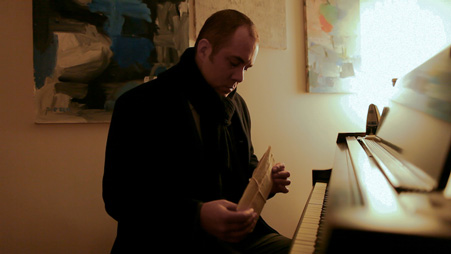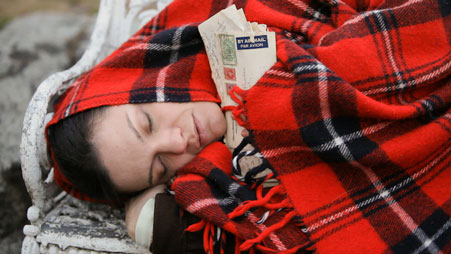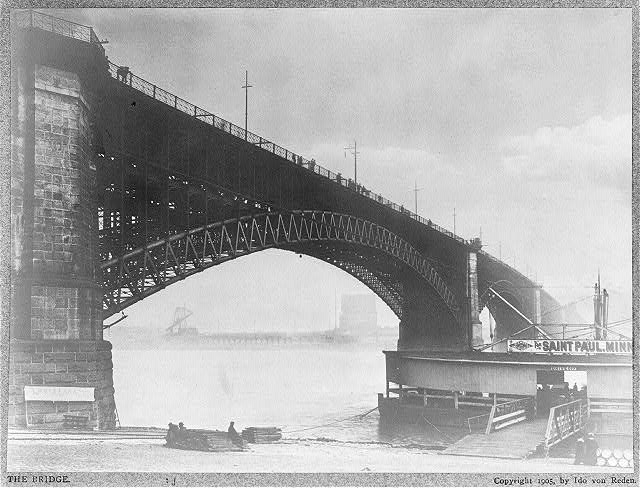“Her Letters” is Kate Chopin’s short story about the husband of a woman who dies before she can destroy letters written to her by her lover.
Photo of Eads Bridge, St. Louis, by Ido von Reden, 1905 (Library of Congress)
By the Editors of KateChopin.org
Read the story in a PDF
Characters
Time and place
Themes
When the story was written and published
Questions and answers
A new film based on the story
Accurate texts
New All of Kate Chopin’s short stories in Spanish
An article about the story
Books that discuss Kate Chopin’s short stories
Kate Chopin’s “Her Letters” online and in print
You can read the story and download it in our accurate, printable, and searchable PDF file, which is based on The Complete Works of Kate Chopin, edited by Per Seyersted (Baton Rouge: Louisiana State UP, 1969, 2006). If you’re citing a passage from this or other Kate Chopin stories for research purposes, it’s a good idea to check your citation against one of these printed texts.
In print you can find “Her Letters” in The Complete Works of Kate Chopin, in the Penguin Classics edition of Chopin’s A Vocation and a Voice, and in the Library of America Kate Chopin volume, as well as in other paperback and hardcover books. For publication information about these books, see the section “For students and scholars” near the bottom of this page.
“Her Letters” characters
- Unnamed woman
- Unnamed man, the woman’s husband
“Her Letters” time and place
The story takes place in an unnamed city, apparently in the late nineteenth century. Because Chopin describes the man walking across “the bridge that spanned the river–the deep, broad, swift, black river dividing two States,” she was probably thinking of St. Louis, where she was living when she wrote the story, and she is probably referring to the famous Eads Bridge, completed in 1874, which spans the Mississippi River at St. Louis.
“Her Letters” themes
As we explain in the questions and answers below, readers often wonder about where Kate Chopin got the idea for this story and why she did not give names to the characters. Some people find resemblances between the woman in this story and Edna Pontellier in The Awakening.
You can read about finding themes in Kate Chopin’s stories and novels on the Themes page of this site.
When Kate Chopin’s “Her Letters” was written and published
The story was written on November 29, 1894, and published in Vogue on April 11, 18, 1895, one of nineteen Kate Chopin stories that Vogue published. Chopin apparently intended the story to be included in her third collection of stories, to have been called A Vocation and a Voice, but the volume was for unknown reasons cancelled by the publisher and did not appear as a separate volume until 1991.
Chopin also wrote “The Story of an Hour” in 1894 (on April 19) and “Lilacs” (May 14–16). The following year she wrote “Athénaïse” (April 10–28, 1895) and “Fedora” (November 19).
You can find out when Kate Chopin wrote each of her short stories and when and where each was first published.
Questions and answers about “Her Letters”
Q: Do scholars know what inspired Chopin to write this story?
A: Emily Toth writes in her 1999 Chopin biography that Carrie Blackman, a woman whom Chopin considered “woefully unballanced” may have inspired it. Chopin dedicated a poem to Blackman, whose “loveliness,” Toth says, “her air of secrecy, and her paintings of women also seem to have inspired” the story.
Mary Papke in Awakenings: The Story of the Kate Chopin Revival notes that Chopin wrote the story in the same year as she translated Guy de Maupassant’s short story “A Divorce Case.” This story and other Maupassant stories that Chopin translated, Papke argues, describe “intensely disturbed states of mind, what the characters themselves refuse to admit may be sociopathological states of being but in some cases clearly are.”
And there may have been other inspirations. Émile Zola describes a woman with a secret lover in his novel Lourdes, published in 1894. Chopin reviewed the novel a few days before she wrote “Her Letters.”
Q: Why didn’t Kate Chopin give names to these characters?
A: “Why” questions are tough to answer. Scholars rarely understand exactly why artists do what they do. But Barbara Ewell writes that in “Her Letters” the characters’ anonymity deepens the “sense of mystery and distance, which intensifies in the ironic contrast between our intimate perspective on the woman and the misperceptions of her character by her husband and closest friends.”
Q: Chopin’s Awakening describes Edna Pontellier living a “dual life.” Isn’t the woman in this story also doing that?
A: Yes, although Chopin says that Edna “apprehended instinctively the dual life–that outward existence which conforms, the inner life which questions.” But for the woman in “Her Letters,” as for Adrienne Farival in “Lilacs,” Bernard Koloski writes, “two separate existences are ‘outward.’ They are hidden from each other and incompatible–but they are lived, not only imagined, as are Mrs. Mallard’s reveries [in “The Story of an Hour”] or Edna Pontellier’s adolescent fantasies about romantic men.”
You can read more questions and answers about Kate Chopin and her work, and you can contact us with your questions.
A New Film Based on “Her Letters”
New York filmmaker Amanda Lin Costa has written, directed, and produced a contemporary film adaptation of Kate Chopin’s short story “Her Letters.”

The executive producer of the film, Karla S. Bryant, tells us:
“I leave this package to the care of my husband. With perfect faith in his loyalty and his love, I ask him to destroy it unopened.
“These two lines, written over a century ago by Kate Chopin, were the catalyst for Amanda Lin Costa’s vision for a short film. Remaining faithful to the story, the contemporary setting emphasizes the timeless qualities of the themes of love, doubt, suspicion, and despair. In keeping with Kate Chopin’s astute eye for subtle detail, the film is rich in visuals and moments which capture a multitude of emotions.”

“Once the post-production work is finished on the film,” Ms. Bryant adds, “our plan is to enter it in several quality film festivals and explore future distribution venues. A percentage of funds raised will support New York Women in Film and Television. We believe this is a strong project which highlights the uncompromising creativity of Kate Chopin, presented as a film to a wider audience.”
Amanda Lin Costa has done an interview about the film. And the interview now has a second part. Our thanks to Karla Bryant for the film stills.
For students and scholars
Accurate texts of “Her Letters”
The Complete Works of Kate Chopin. Edited by Per Seyersted. Baton Rouge: Louisiana State UP, 1969, 2006.
A Vocation and a Voice. Edited by Emily Toth. New York: Penguin, 1991.
Kate Chopin: Complete Novels and Stories. Edited by Sandra Gilbert. New York: Library of America, 2002.
An article about “Her Letters”
The article is available online through many university or public libraries.
Weinstock, Jeffrey Andrew. “In Possession of the Letter: Kate Chopin’s ‘Her Letters’.” Studies in American Fiction 30.1 (2002): 45-62.
Books that discuss Chopin’s short stories
Fox, Heather A. Arranging Stories: Framing Social Commentary in Short Story Collections by Southern Women Writers. University Press of Mississippi, 2022.
Ostman, Heather. Kate Chopin and Catholicism. Palgrave Macmillan, 2020.
Ostman, Heather, and Kate O’Donoghue, eds. Kate Chopin in Context: New Approaches. New York: Palgrave Macmillan, 2015. The book contains these essays:
Koloski, Bernard. “Chopin’s Enlightened Men”: 15–27.
Walker, Rafael. “Kate Chopin and the Dilemma of Individualism”: 29–46.
Armiento, Amy Branam. “‘A quick conception of all that this accusation meant for her’: The Legal Climate at the Time of ‘Désirée’s Baby’”: 47–64.
Rossi, Aparecido Donizete. “The Gothic in Kate Chopin”: 65–82.
Gil, Eulalia Piñero. “The Pleasures of Music: Kate Chopin’s Artistic and Sensorial Synesthesia”: 83–100.
Ostman, Heather. “Maternity vs. Autonomy in Chopin’s ‘Regret’”: 101–15.
Merricks, Correna Catlett. “‘I’m So Happy; It Frightens Me’: Female Genealogy in the Fiction of Kate Chopin and Pauline Hopkins”: 145–58.
Sehulster, Patricia J. “American Refusals: A Continuum of ‘I Prefer Not Tos’ as Articulated in the Work of Chopin, Hawthorne, Harper, Atherton, and Dreiser”: 159–72.
Rajakumar, Mohanalakshmi and Geetha Rajeswar. “What Did She Die of? ‘The Story of an Hour’ in the Middle East Classroom”: 173–85.
O’Donoghue, Kate. “Teaching Kate Chopin Using Multimedia”: 187–202.
James Nagel. Race and Culture in New Orleans Stories: Kate Chopin, Grace King, Alice Dunbar-Nelson, and George Washington Cable. Tuscaloosa: U of Alabama P, 2014.
Brosman, Catharine Savage. Louisiana Creole Literature: A Historical Study. UP of Mississippi, 2013.
Wan, Xuemei. Beauty in Love and Death—An Aesthetic Reading of Kate Chopin’s Works [in Chinese]. China Social Sciences P, 2012.
Hebert-Leiter, Maria. Becoming Cajun, Becoming American: The Acadian in American Literature from Longfellow to James Lee Burke. Baton Rouge: Louisiana State UP, 2009.
Gale, Robert L. Characters and Plots in the Fiction of Kate Chopin. Jefferson, N C: McFarland, 2009.
Beer, Janet, ed. The Cambridge Companion to Kate Chopin. Cambridge, England: Cambridge UP, 2008. The book contains these essays:
Knights, Pamela. “Kate Chopin and the Subject of Childhood”: 44–58.
Castillo, Susan. “’Race’ and Ethnicity in Kate Chopin’s Fiction”: 59–72.
Joslin, Katherine. “Kate Chopin on Fashion in a Darwinian World”: 73–86.
Worton, Michael. “Reading Kate Chopin through Contemporary French Feminist Theory”: 105–17.
Horner, Avril. “Kate Chopin, Choice and Modernism”: 132–46.
Taylor, Helen. “Kate Chopin and Post-Colonial New Orleans”: 147–60.
Ostman, Heather, ed. Kate Chopin in the Twenty-First Century: New Critical Essays. Newcastle upon Tyne, England: Cambridge Scholars, 2008. The book contains these essays:
Kornhaber, Donna, and David Kornhaber. “Stage and Status: Theatre in the Short Fiction of Kate Chopin”: 15–32.
Thrailkill, Jane F. “Chopin’s Lyrical Anodyne for the Modern Soul”: 33–52.
Johnsen, Heidi. “Kate Chopin in Vogue: Establishing a Textual Context for A Vocation and a Voice”: 53–69.
Batinovich, Garnet Ayers. “Storming the Cathedral: The Antireligious Subtext in Kate Chopin’s Works”: 73–90.
Kirby, Lisa A. “‘So the storm passed . . .’: Interrogating Race, Class, and Gender
in Chopin’s ‘At the ’Cadian Ball’ and ‘The Storm’”: 91–104.
Frederich, Meredith. “Extinguished Humanity: Fire in Kate Chopin’s ‘The Godmother’”: 105–18.
Beer, Janet. Kate Chopin, Edith Wharton and Charlotte Perkins Gilman: Studies in Short Fiction. New York: Palgrave Macmillan, 2005.
Stein, Allen F. Women and Autonomy in Kate Chopin’s Short Fiction. New York: Peter Lang, 2005.
Lohafer, Susan. Reading for Storyness: Preclosure Theory, Empirical Poetics and Culture in the Short Story. Baltimore, MD: Johns Hopkins UP, 2003.
Shaker, Bonnie James. Coloring Locals: Racial Formation in Kate Chopin’s Youth’s Companion Stories. Iowa City: U of Iowa P, 2003.
Perrin-Chenour, Marie-Claude. Kate Chopin: Ruptures [in French]. Paris, France: Belin, 2002.
Evans, Robert C. Kate Chopin’s Short Fiction: A Critical Companion. West Cornwall, CT: Locust Hill, 2001.
Koloski, Bernard, ed. Bayou Folk and A Night in Acadie by Kate Chopin. New York: Penguin, 1999.
Beer, Janet. Kate Chopin, Edith Wharton and Charlotte Perkins Gilman: Studies in Short Fiction. New York: Macmillan–St. Martin’s, 1997.
Koloski, Bernard. Kate Chopin: A Study of the Short Fiction. New York: Twayne, 1996.
Petry, Alice Hall, ed. Critical Essays on Kate Chopin. New York: G. K. Hall, 1996. The book contains these essays:
Pollard, Percival. “From Their Day in Court“: 67–70.
Reilly, Joseph J. “Stories by Kate Chopin”: 71–74.
Skaggs, Peggy. “The Boy’s Quest in Kate Chopin’s ‘A Vocation and a Voice’”: 129–33.
Dyer, Joyce [Coyne]. “The Restive Brute: The Symbolic Presentation of Repression and Sublimation in Kate Chopin’s ‘Fedora’”: 134–38.
Arner, Robert D. “Pride and Prejudice: Kate Chopin’s ‘Désirée’s Baby’”: 139–46.
Bauer, Margaret D. “Armand Aubigny, Still Passing After All These Years: The Narrative Voice and Historical Context of ‘Désirée’s Baby’”: 161–83.
Berkove, Lawrence I. “‘Acting Like Fools’: The Ill-Fated Romances of ‘At the ’Cadian Ball’ and ‘The Storm’”: 184–96.
Wagner-Martin, Linda. “Kate Chopin’s Fascination with Young Men”: 197–206.
Walker, Nancy A. “Her Own Story: The Woman of Letters in Kate Chopin’s Short Fiction”: 218–26.
Elfenbein, Anna Shannon. Women on the Color Line: Evolving Stereotypes and the Writings of George Washington Cable, Grace King, Kate Chopin. Charlottesville: UP of Virginia, 1994.
Fick, Thomas H., and Eva Gold, guest eds. “Special Section: Kate Chopin.” Louisiana Literature: A Review of Literature and Humanities. Spring, 1994. 8–171. The special section of the journal contains these essays:
Toth, Emily. “Introduction: A New Generation Reads Kate Chopin”: 8–17.
Koloski, Bernard. “The Anthologized Chopin: Kate Chopin’s Short Stories in Yesterday’s and Today’s Anthologies”: 18–30.
Saar, Doreen Alvarez. “The Failure and Triumph of ‘The Maid of Saint Phillippe’: Chopin Rewrites American Literature for American Women”: 59–73.
Dyer, Joyce. “‘Vagabonds’: A Story without a Home”: 74–82.
Padgett, Jacqueline Olson. “Kate Chopin and the Literature of the Annunciation, with a Reading of ‘Lilacs’”: 97–107.
Day, Karen. “The ‘Elsewhere’ of Female Sexuality and Desire in Kate Chopin’s ‘A Vocation and a Voice’”: 108–17.
Cothern, Lynn. “Speech and Authorship in Kate Chopin’s ‘La Belle Zoraïde’”: 118–25.
Lundie, Catherine. “Doubly Dispossessed: Kate Chopin’s Women of Color”: 126–44.
Ellis, Nancy S. “Sonata No. 1 in Prose, the ‘Von Stoltz’: Musical Structure in an Early Work by Kate Chopin”: 145–56.
Ewell, Barbara C. “Making Places: Kate Chopin and the Art of Fiction”: 157–71.
Boren, Lynda S., and Sara deSaussure Davis (eds.), Kate Chopin Reconsidered: Beyond the Bayou. Baton Rouge: Louisiana State UP, 1992. The book contains these essays:
Toth, Emily. “Kate Chopin Thinks Back Through Her Mothers: Three Stories by Kate Chopin”: 15–25.
Bardot, Jean. “French Creole Portraits: The Chopin Family from Natchitoches Parish”: 26–35.
Thomas, Heather Kirk. “‘What Are the Prospects for the Book?’: Rewriting a Woman’s Life”: 36–57.
Black, Martha Fodaski. “The Quintessence of Chopinism”: 95–113.
Ewell, Barbara C. “Kate Chopin and the Dream of Female Selfhood”: 157–65.
Davis, Sara deSaussure. “Chopin’s Movement Toward Universal Myth”: 199–206.
Blythe, Anne M. “Kate Chopin’s ‘Charlie’”: 207–15.
Ellis, Nancy S. “Insistent Refrains and Self-Discovery: Accompanied Awakenings in Three Stories by Kate Chopin”: 216–29.
Toth, Emily, ed. A Vocation and a Voice by Kate Chopin. New York: Penguin, 1991.
Showalter, Elaine. Sister’s Choice: Tradition and Change in American Women’s Writing. Oxford, England: Oxford UP, 1991.
Papke, Mary E. Verging on the Abyss: The Social Fiction of Kate Chopin and Edith Wharton. New York: Greenwood, 1990.
Elfenbein, Anna Shannon. Women on the Color Line: Evolving Stereotypes and the Writings of George Washington Cable, Grace King, Kate Chopin. Charlottesville: UP of Virginia, 1989.
Taylor, Helen. Gender, Race, and Region in the Writings of Grace King, Ruth McEnery Stuart, and Kate Chopin. Baton Rouge: Louisiana State UP, 1989.
Bonner, Thomas Jr., The Kate Chopin Companion. New York: Greenwood, 1988.
Bloom, Harold, ed. Kate Chopin. New York: Chelsea, 1987. The book contains these essays:
Ziff, Larzer. “An Abyss of Inequality”: 17–24.
Wolff, Cynthia Griffin. “The Fiction of Limits: ‘Désirée’s Baby’”: 35–42.
Dyer, Joyce C. “Gouvernail, Kate Chopin’s Sensitive Bachelor”: 61–69.
Dyer, Joyce C. “Kate Chopin’s Sleeping Bruties”: 71–81.
Gardiner, Elaine. “‘Ripe Figs’: Kate Chopin in Miniature”: 83–87.
Ewell, Barbara C. Kate Chopin. New York: Ungar, 1986.
Skaggs, Peggy. Kate Chopin. Boston: Twayne, 1985.
Toth, Emily, ed. Regionalism and the Female Imagination. New York: Human Sciences Press, 1984.
Stein, Allen F. After the Vows Were Spoken: Marriage in American Literary Realism. Columbus: Ohio UP, 1984.
Huf, Linda. A Portrait of the Artist as a Young Woman: The Writer as Heroine in American Literature. New York: Ungar, 1983.
Christ, Carol P. Diving Deep and Surfacing: Women Writers on Spiritual Quest. Boston: Beacon, 1980.
Springer, Marlene. Edith Wharton and Kate Chopin: A Reference Guide. Boston: Hall, 1976.
Cahill, Susan. Women and Fiction: Short Stories by and about Women. New York: New American Library, 1975.
Seyersted, Per, ed. “The Storm” and Other Stories by Kate Chopin: With The Awakening. Old Westbury: Feminist P, 1974.
Freedman, Florence B., et al. Special Issue: Whitman, Chopin, and O’Faolain. WWR, 1970.
Leary, Lewis, ed. The Awakening and Other Stories by Kate Chopin. New York: Holt, Rinehart and Winston, 1970.
Seyersted, Per. Kate Chopin: A Critical Biography. Baton Rouge: Louisiana State UP, 1969.
Rankin, Daniel, Kate Chopin and Her Creole Stories. Philadelphia: U of Pennsylvania P, 1932.
